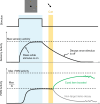Memorable first impressions
- PMID: 38700912
- PMCID: PMC11068352
- DOI: 10.7554/eLife.98274
Memorable first impressions
Abstract
Our ability to recall details from a remembered image depends on a single mechanism that is engaged from the very moment the image disappears from view.
Keywords: delay encoding; human; iconic memory; neuroscience; population coding; short-term memory; temporal dynamics.
© 2024, Salinas and Sheikh.
Conflict of interest statement
ES, BS No competing interests declared
Figures

Comment on
- doi: 10.7554/eLife.91034
References
Publication types
MeSH terms
LinkOut - more resources
Full Text Sources

